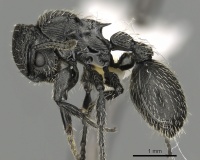Procryptocerus tortuguero
| Procryptocerus tortuguero | |
|---|---|

| |
| Scientific classification | |
| Kingdom: | Animalia |
| Phylum: | Arthropoda |
| Class: | Insecta |
| Order: | Hymenoptera |
| Family: | Formicidae |
| Subfamily: | Myrmicinae |
| Tribe: | Attini |
| Genus: | Procryptocerus |
| Species: | P. tortuguero |
| Binomial name | |
| Procryptocerus tortuguero Longino & Snelling, 2002 | |
The nest series from which the holotype was selected was collected from lowland rainforest. The nest was in a trailside woody plant stem whose apex was an old machete cut. The ants inhabited the dead terminus of the branch, just distal to the live portion. The live stem was solid, and the ants were in chambers excavated either by themselves or by a previous stem-boring insect. The entire nest was sampled and contained 108 workers, one dealate queen, one alate queen, and brood. The other specimens from the type locality were collected from low vegetation. The worker from below Volcan Barba was collected from the canopy of primary rainforest, approximately 20 m high. Workers from 17 km south of Puerto Viejo were in the crown of a recent treefall in primary wet forest. (Longino and Snelling 2002)
Identification
Keys including this Species
Distribution
Latitudinal Distribution Pattern
Latitudinal Range: 10.53333333° to 10.03333333°.
| North Temperate |
North Subtropical |
Tropical | South Subtropical |
South Temperate |
- Source: AntMaps
Distribution based on Regional Taxon Lists
Neotropical Region: Colombia, Costa Rica (type locality).
Distribution based on AntMaps
Distribution based on AntWeb specimens
Check data from AntWeb
Countries Occupied
| Number of countries occupied by this species based on AntWiki Regional Taxon Lists. In general, fewer countries occupied indicates a narrower range, while more countries indicates a more widespread species. |

|
Estimated Abundance
| Relative abundance based on number of AntMaps records per species (this species within the purple bar). Fewer records (to the left) indicates a less abundant/encountered species while more records (to the right) indicates more abundant/encountered species. |

|
Biology
Castes
Nomenclature
The following information is derived from Barry Bolton's Online Catalogue of the Ants of the World.
- tortuguero. Procryptocerus tortuguero Longino & Snelling, 2002: 28, fig. 1F (w.q.) COSTA RICA.
Unless otherwise noted the text for the remainder of this section is reported from the publication that includes the original description.
Description
Worker
Holotype: HW 1.615, HL 1.462, SL 0.812, EL 0.365, MeL 1.821, MeW 1.165, PrW 0.812, PrL 0.552, PrS 0.236, PrT 0.787, MTL 1.015, PtL 0.555, PtW 0.457, PpW 0.592, PtH 0.452, AL 1.821, AW 1.510, ASW 0.041.
Paratype: (LACM ENT 141766): HW 1.572, HL 1.469, SL 0.810, EL 0.375, MeL 1.958, MeW 1.239, MTL 1.041, MFL 1.092, MFW 0.383, PtL 0.613, PtW 0.429, PpW 0.575, PtH 0.455, AL 1.977, AW 1.560.
Similar to Procryptocerus impressus, Procryptocerus paleatus, and Procryptocerus subpilosus; entire disc of the face with evenly dispersed erect setae; face sculpture, head shape, mesosomal profile, mesonotal teeth, propodeal suture, mesosomal sculpture, petiole shape and sculpture, and postpetiole shape and sculpture similar to P. paleatus; striae on the first gastral tergite fade out distally and posteriorly, similar to P. subpilosus; density of pilosity on gaster intermediate between P. impressus and P. paleatus, setae aligned on longitudinal axis subcontiguous, not or barely overlapping, but not as widely spaced as on P. paleatus.
Kempf (1951:53), identifying the series from Zent as P. paleatus, thoroughly described the worker.
Shape, sculpture, and pilosity as in worker, except for mesosomal characters typical of caste; pronotum with coarse piligerous foveae, confluent laterally and posteriorly, smaller and separated by broad interspaces anteromedially; mesoscutum, axillae, and scutellum with mixture of longitudinal rugae and elongate piligerous foveae; dorsal face of propodeum with longitudinal, vermiculate rugae; wings smoky brown.
Type Material
HOLOTYPE WORKER. Costa Rica, Prov. Limon, Tortuguero, 108329N 838319W, ,5 m, 1–5 Jul 1985 (Longino #382) Instituto Nacional de Biodiversidad. Barcode: LACM ENT 141741.
PARATYPES. All from same nest series as holotype. One alate queen, LACM ENT 141766 [INBC]; one worker and one dealate queen, LACM ENT 141755 Los Angeles County Museum of Natural History; two workers, LACM ENT 141765 The Natural History Museum; two workers, LACM ENT 140647 Centro de Pesquisas do Cacau; two workers, LACM ENT 141742 Museum of Comparative Zoology; two workers, LACM ENT 141743 Musee d'Histoire Naturelle Genève; two workers, LACM ENT 141744 Museu de Zoologia da Universidade de Sao Paulo; two workers, LACM ENT 141745 Naturhistorisches Museum, Basel; two workers, LACM ENT 141746 Philip S. Ward Collection; two workers, LACM ENT 141747 National Museum of Natural History; two workers, LACM ENT 141748 John T. Longino Collection; two workers, LACM ENT 141749 CHAH.
Etymology
This species is named for the type locality. It is a noun in apposition, and thus invariant.
References
- Guerrero, R.J., Fernandez, F., Escarraga, M.E., Perez-Pedraza, L.F., Serna, F., Mackay, M.P., Sandoval, V., Vergara, V., Suarez, D., Garcia, E.I., Sanchez, A., Meneses, A.D., Tocora, M.C., Sosa-Calvo, J. 2018. New records of myrmicine ants (Hymenoptera: Formicidae) for Colombia. Revista Colombiana de Entomología 44: 238-259 (DOI 10.25100/socolen.v44i2.7115).
- Longino, J.T. and Snelling, R.R. 2002. A taxonomic revision of the Procryptocerus of Central America. Contributions in Science. 495:1-30.
References based on Global Ant Biodiversity Informatics
- Fernández, F. and S. Sendoya. 2004. Lista de las hormigas neotropicales. Biota Colombiana Volume 5, Number 1.
- INBio Collection (via Gbif)
- Longino J. T. and Snelling R. R. 2002. A taxonomic revision of the Procryptocerus (Hymenoptera: Formicidae) of Central America. Contributions in Science (Los Angeles) 495: 1-30
- Longino J. et al. ADMAC project. Accessed on March 24th 2017 at https://sites.google.com/site/admacsite/

